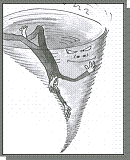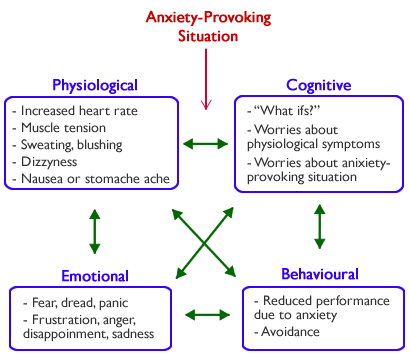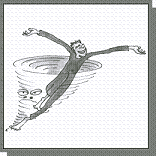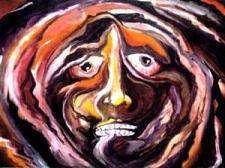 According to the cognitive behavioural therapy (CBT) approach to anxiety, one of the reasons that overcoming anxiety can be so difficult is that anxiety generates vicious cycles involving your physiological, cognitive, behavioural, and emotional domains. We looked at these four components of anxiety in a previous post. Now we’ll look at how they act together to form vicious cycles that create and maintain anxiety.
According to the cognitive behavioural therapy (CBT) approach to anxiety, one of the reasons that overcoming anxiety can be so difficult is that anxiety generates vicious cycles involving your physiological, cognitive, behavioural, and emotional domains. We looked at these four components of anxiety in a previous post. Now we’ll look at how they act together to form vicious cycles that create and maintain anxiety. In the cognitive behavioural therapy (CBT) model of anxiety, the vicious cycle begins with an anxiety-provoking situation. This situation can be something external such as a work commitment, a trip, a social engagement, or any other event happening in the future that you’re worried about. Anxiety can also be provoked by something internal such as a physiological sensation, a thought about something you’re dreading, or an unpleasant emotion.
This anxiety-provoking situation then triggers a vicious cycle involving the four domains, as depicted below:

For example, you’re at a social event, and feeling shy, and this triggers a physiological response such as increased heart rate, or blushing, or sweaty hands. You become aware of this physiological symptom and think, “Oh no. Everyone just saw me blush”; or “What am I going to say? I have nothing to talk about.”
This thought can lead to more physiological symptoms. Or perhaps it leads to an emotional response, and you start feeling nervous or scared. And this leads to a behaviour, such as stuttering or mumbling your words, or just not saying anything. This can lead to another thought: “I’m making a fool of myself. Why did I even bother to go out?” And this can feed into further physiological symptoms, or thoughts, or emotions, or behaviours, each of which generate increased anxiety.
Panic attacks usually begin with a physiological symptom. Perhaps you notice your heart rate increase. Then you start thinking, “Something’s wrong. I’m going to have a heart attack.” Then you start feeling scared. This increases your heart rate. And so on. Then, if you can, engage in an avoidance behaviour and flee wherever you are, or vow in the future to avoid the situation that lead to the panic at all costs.
Worrying usually begins with a “What if?” thought. “What if I screw this up?”; “What if something’s wrong?”; “What if something bad happens?” This can lead to emotions such as fear or dread. These emotions can lead to a nervous feeling in the pit of your stomach. When you notice this feeling, on top of everything else, you start to worry about the anxiety you’re experiencing. And so on.
In each of these examples, there was an anxiety-triggering situation that set off a vicious cycle of interactions in which the physiological, cognitive, behavioural and emotional realms feed into each other, creating more and more anxiety.

This cycle is explained in more detail in the video below. To learn how to manage anxiety better, please check out my free Self-Help Course for Anxiety.
In the next post, we’ll look at some of the ways that mindfulness, and cognitive therapy and cognitive behavioural therapy (CBT) for anxiety, can help you break these cycles.

I’m a Guelph therapist specializing in helping people overcome anxiety, depression and low self-esteem. For more information about how I can help you end your vicious cycles through mindfulness and cognitive therapy/cognitive-behavioural therapy (CBT) for anxiety, or to make an appointment for counselling or therapy in Guelph , please call me at 226-500-4086 or email greg@guelphtherapist.ca.



